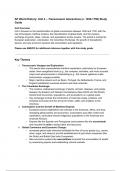AP World History: Unit 4 – Transoceanic Interactions (c. 1450-1750) Study
Guide
Unit Overview:
Unit 4 focuses on the transformation of global connections between 1450 and 1750, with the
rise of European maritime empires, the intensification of global trade, and the massive
exchange of goods, ideas, cultures, and populations across oceans. The period is marked by
European exploration, colonization, the Columbian Exchange, the growth of transatlantic
slavery, and new economic systems like mercantilism and capitalism.
Please use AMSCO for additional reference together with this study guide
Key Themes
1. Transoceanic Voyages and Exploration:
○ This period saw unprecedented maritime exploration, particularly by European
states. New navigational tools (e.g., the compass, astrolabe, and more accurate
maps) and advancements in shipbuilding (e.g., the caravel, galleons) made
transoceanic voyages possible.
○ Major maritime powers such as Spain, Portugal, the Netherlands, France, and
England established overseas empires and trade networks.
2. The Columbian Exchange:
○ The massive, widespread exchange of plants, animals, diseases, and people
between the Eastern and Western Hemispheres (New World and Old World)
transformed economies, populations, and ecosystems on a global scale.
○ Key exchanges include the introduction of crops like maize, potatoes, and
tomatoes to Europe and the arrival of horses, cattle, and smallpox to the
Americas.
3. Colonization and the Growth of Maritime Empires:
○ European powers established vast colonies in the Americas, Africa, and Asia,
reshaping global politics and economics. Colonization was often violent and
exploitative, particularly toward indigenous populations in the Americas and
enslaved Africans.
○ Empires like the Spanish and Portuguese used systems like the encomienda
and recycled the mita to extract labor and resources.
4. Global Commerce and Economic Change:
○ Increased global trade networks facilitated the flow of luxury goods (e.g., spices,
silver, sugar, and tobacco) and the establishment of joint-stock companies (like
the Dutch and British East India Companies).
○ New economic systems like mercantilism promoted the accumulation of wealth
by maximizing exports and establishing colonial markets.
, ○ The silver trade from the Americas to Europe and Asia became the first truly
global exchange.
5. The Atlantic Slave Trade:
○ The demand for labor on American plantations (sugar, tobacco, cotton) led to the
establishment of the transatlantic slave trade, where millions of Africans were
forcibly taken to the Americas under horrific conditions.
○ The Middle Passage was the brutal leg of the triangular trade route in which
enslaved Africans were shipped to the Americas.
○ The trade in enslaved people deeply impacted African societies, depopulating
entire regions and increasing warfare.
6. Cultural and Religious Interactions:
○ The spread of Christianity, particularly through missionary efforts (e.g., Jesuits),
was a significant aspect of European colonization, often leading to syncretic
religions in colonized regions.
○ Global trade facilitated cultural exchanges, blending local traditions with foreign
influences, leading to new forms of art, language, and religious practices.
7. Resistance and Rebellions:
○ Indigenous people in the Americas, enslaved Africans, and others subjected to
European colonization and exploitation often resisted their oppressors through
rebellions, revolts, and covert forms of resistance (e.g., work slowdowns,
maintaining cultural traditions).
Key Events and Processes
1. European Exploration and Conquest
● Portuguese Exploration:
○ Led by figures like Prince Henry the Navigator, Portugal established early
dominance in the Indian Ocean trade routes.
○ Vasco da Gama was the first European to reach India by sea, while Portuguese
explorers also established colonies in Africa, Asia, and Brazil.
● Spanish Conquest:
○ Spain, led by explorers like Christopher Columbus, Ferdinand Magellan, and
Hernán Cortés, colonized large portions of the Americas.
○ The Spanish conquest of the Aztec and Inca Empires in the early 16th century
resulted in the vast transfer of wealth to Spain through the mining of silver and
gold.
● Northwest European Exploration:
○ France, England, and the Netherlands entered the global competition for
colonies, establishing trading posts and settlements in North America, the
Caribbean, Africa, and Asia. English explorer James Cook's voyages to the
Pacific expanded British influence.




